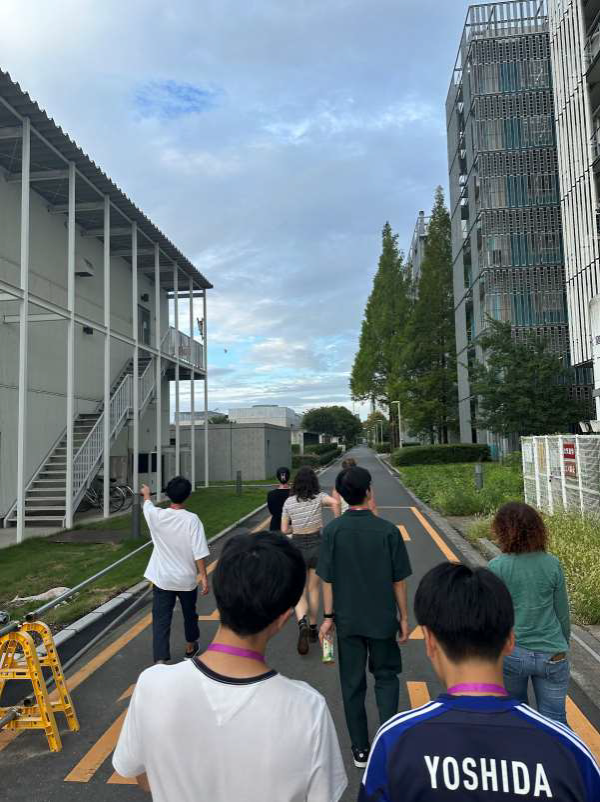グループD DiaryDay1 (9/4)

We began our trip with an opening ceremony with different speakers from universities and embassies from both Australia and Japan. From their talks we learnt about a few cultural differences. The Australians always did an Acknowledgment of Country before starting their speeches to acknowledge the traditional owners of the land, while this was not necessary for the Japanese speakers, due to the different histories of the countries. We learnt that the University of Tokyo (U-Tokyo) and the Australian National University (ANU) have a strong partnership, as U-Tokyo is one of ANU’s closest ‘allies’, and that this course helps to reinforce this relationship. From the opening ceremony we also learnt that international experiences like these are beneficial for both the universities involved and the students. This benefits the students as they can experience the culture of the host country, along with gaining academic experiences that are not possible in their home countries. For example, on this trip we will learn about tsunamis and earthquakes, things that cannot be learnt first hand in Australia. In addition to this, the students involved in the international experience will be able to gain valuable life experiences and make lifelong memories. Student exchange benefits the universities involved by strengthening the relationship between the universities, and this would also benefit future students as if the relationship between universities is strong, it’s likely that trips like this will continue into the future.
After the opening ceremony we met our group mates for the first time. When greeting each other, Kyota adjusted to the international way of communication by shaking hands but usually Japanese people don’t do that when they first meet. This was a nice gesture that was much appreciated by the Australian students, and made them feel very welcome. The normal Japanese greeting for meeting new people would be to bow and say hello. We (the aussies) noticed this today when meeting anyone new, for example the Japanese teachers. Another surprising thing we learnt when talking to each other was that it’s common for students to live off campus in both cities. We all expected to hear that the students from the other university lived on campus, but this wasn’t the case for most of our group, which we found surprising.
Our first lecture for the course was about science communication. This was a new topic for some of our group members, especially since science communication is not widely known or studied in Japan. The lecture started with the story about L’Aquila and from this we learnt that communicating about hazards influences people’s responses and behavior. This is an example about what happens if geohazard science communication is not done responsibly. It was interesting to learn how real the consequences of this can be, particularly that some of the government officials ended up in jail because of their science communication. This is something that we will keep in mind when learning about science communication for geohazards later in the course. After learning this information, we did a science communication activity where in pairs we attempted to communicate effectively with someone from a completely different era. This showed us that science communication is much harder than we were expecting (we were all burnt at the stake for our communication, for example referring to a phone as a magical box). After this activity we were able to see what makes good and bad science communication through reflecting on what went well and what didn’t go well. Caitlyn and Kyota were surprised that explaining ‘how’ can be a bad thing in science communication (because the examples you use can scare your audience, for example, saying that light in x-rays cuts your skin). This will definitely influence how we communicate science in the future, as we will focus on explaining the ‘what’ (what the science topic is, e.g. x-rays can let us see into your finger) and why the topic is relevant to the audience (e.g. it can help you get better). When we do explain the ‘how’ of the science, we will be extra careful to make sure our examples don’t have negative connotations.
Our next activity was to tour the aquarium, which we learnt has been part of AORI from the very beginning. We learnt that the researchers are taking blood samples to identify changes in the hormones of fish, specifically testosterone and estrogen. The samples are being taken from two different species of fish (one species hatches from eggs, and the other is born through live birth), to learn about the reproductive systems of the fish. This might be important for geohazards as the fish might be able to detect upcoming natural disasters, in the way that dogs and cats can predict oncoming storms. Or this research may help us understand behavioural changes in fish after natural disasters, to see how the fish adapt.
Finally we concluded our day by touring the laboratory for Accelerator Mass Spectrometry. Before entering the lab we heard “Yuyake Koyake” playing out loud in the street, at 5pm to make the children go back home. We learnt that it is played in rural areas, and less in the cities. When entering the lab we also had another moment of cultural learning, when we had to take our shoes off and put slippers on before entering the lab. After speaking with Kyota and Katsuki, we learnt that this could just be because of Mr Yokoyama’s preference, or to keep the lab clean. In the lab tour, we learnt that Carbon 14 dating can be used to determine atmospheric carbon.



